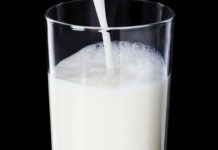
Condensed Milk, and Evapoorated Milk are often confused with each other. Condensed, and Evaporated are similar terms, but the resemblance ends there. Unsweeted Condensed Milk is Evaporated Milk, and is always labeled as Evaporated Milk. Sweetened Condensed Milk is a different milk product, and two are not interchangeable.
Evaporated milk is just what the name says. It is normal milk that has been heated, usually by steam, until it has evaporated to 40% of it’s original volume. This means that 60% of its water has been removed. This does a couple of things. First, it concentrates the milk sugars, making the milk appear to be sweeter by volume, and second, it increases the viscosity of the milk. In other words, it makes it thicker. This is important on some recipes, because the evaporated milk supplies a lot of the body of the finished product. It is usually used as a lighter version of heavy cream, in baked goods, desserts, soups and sauces. Evaporated milk has a very long shelf life. It is usually a good idea to keep a lot in the pantry for emergencies, and prepardness. It can be turned back into drinkable regular milk (of a sort) simply by mixing it with an equal portion of water. If you are weight-conscious, it also comes in low-fat, and non-fat versions. If you are lactose-intolerant, goats milk Evaporated Milk is also available. For a substitute, you can make a version of Evaporated Milk by using powdered milk, and only use 1/2 of the water that you would normally use. You can also use a double boiler and just reduce regular milk yourself, but it’s really not worth the effort. It’s easier just make a quick trip to the store.
Condensed Milk is actually Sweetened Condensed Milk. This is evaporated milk that has had a lot of sugar added, as much as 40% by weight, and is heated until the sugars start to carmelize. This makes the milk syrupy, custardy-thick and extremely sweet. It supplies body and a lot of sweetness to baked goods, and some drinks and candies. If you need Condensed Milk, and don’t have any on hand, there are several work-arounds. The easiest is to add 30%-40% sugar to unflavored yogurt. The same technique also works for kefir. You can also add 40% sugar to Evaporated Milk and heat it up until it thickens to a thin pudding-like consistency, and begins to slightly carmelize. Again, it’s not really worth all the trouble. Unless you live in a very remote area, a trip to the store is much easier. The powdered milk trick won’t work for Condensed Milk unless you heat it up in a double-boiler, because part of the flavor of Condensed Milk comes from the slightly carmelizes sugars. It’s not worth the trouble. If you are diabetic, or don’t want all the sugar, you can use Splenda (sucralose) in the yogurt, because the yogurt is already thick enough (Splenda does not add body, like real sugar does….). Bear in mind, this is not Sugar-Free, because the yogurt contains some sugar in the form of lactose, nor is it calorie-free. You can’t get something for nothing.
These tricks should help you in the kitchen when you have a temporary shortage of these two products. Of course, the very best way to avoid these situations is to practice good kitchen procedures by assembling all of your ingredients well before you start cooking.





